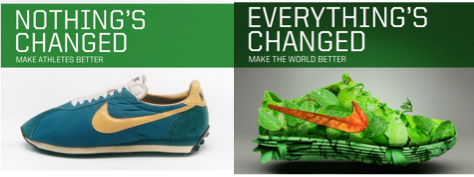This series of posts aims at showing how fashion companies are changing the way they conduct business to make it a better business. We will look at the achievements of these businesses in terms of innovation and sustainability and, possibly, how these achievements affect their business.
In the 1990s Nike was caught in a sweatshop scandal showing poor working conditions in the Asian factories of its suppliers. Celebrities started to boycott the brand that lost several contracts. The company’s total sales dropped from $9 billion in 1998 to $8.8 billion in 1999 and the market share fell from 35.5% in 1997 to 30% in 1998. Since then many things have changed. The brand’s mission and purpose have evolved considerably.

In the 80s the company aimed at “continually produce new and better shoes which will aid performance and reduce or eliminate injury”.
In the 90s, after some 25 years of activity, Nike said it would be there in the next 25 years to “help athletes perform better” with better shoes.
Today Nike wants to “bring inspiration and innovation to every athlete in the world”. The evolution of the company’s mission is powerful because it adds meaning and purpose to its existence: from “produce”, to “help” to eventually “inspire and innovate”.
Since 1998, when Nike launched its first Environmental Policy, the brand has been working hard to review the way they conduct business going well beyond mere compliance.
Main achievements as per 2010/2011 Corporate Responsibility report
Better Design
The Considered Design tool includes a comprehensive Restricted Substance List, and a Materials Policy.
The Material Sustainability Index has been upgraded: it now rates also suppliers based on the environmental performances of their factories and not only on the performances of materials.
The Sustainable Chemistry Guidance encourages all suppliers to use the Principles of Green Chemistry to inspire innovation. More than 300 apparel and footwear suppliers have voluntary joined the programme.
Nike signed Better Cotton Initiative “Fast Track Program” in 2011. The programme channels funds directly to farmer training and improvement programs, to grow better cotton production capacity quicker.
Better and alternative materials
The use of environmentally preferred materials (EPMs) has been increased by 9.8% in apparel production and by 77% in shoe production between 2005 and 2009. Every shoe has now an average of 8 EPMs over a total of 32 materials. As an example, environmentally preferred rubber was used in 80% of all footwear => it was 3% in 2004.
31.5 million of garments were made of (mechanically) recycled polyester in 2011 => it was 3,400 in 2004.
7 million of Kg of organic cotton accounting for 10% of all used cotton was used in 2011 and 90% of all apparel included at least 5% of organic cotton => it was 47% in 2004.
Waste prevention and recycling
85% of total waste generated by footwear suppliers was destined to in-house recycling, closed-loop recycling, downcycling.
Since 1990 25 million of shoes have been recycled through Reuse-a-Shoe Program.
Better resource efficiency
The weight of shoe boxes have been reduced by 23%.
CO2 emissions in footwear production were reduced by 6% since 2008 while increased production by 20%.
Nike Water Program was started in 2001 to help material vendors address their wastewater quality. The programmes had 50 material vendors on board in 2011, and now it counts more than 500 vendors.
Transparency and sharing
The public release of the Considered Design Tool shows leadership and the Sustainable Apparel Coalition’s Higg Index is largely based on it (besides on the Eco Index).
39% of factory audits were shared with other brands through Fair Factory Clearinghouse.
Better manufacturing
The Sourcing and Manufacturing Sustainability Index rates factories on lean manufacturing, environmental performance, labour and health and safety beyond compliance.
=> Lean manufacturing systems have been implemented in Nike’s factories since 2002. Results: increased productivity by 10-20%; 50% less production defects when compared to non-lean factories; lead times have been reduced by 40%; factories have reduced the time it takes to introduce a new model by 30%.
A new Manufacturing Index (MI) was implemented in 2012. It integrates scores from key performance areas into a single dashboard rating factories as Gold, Silver, Bronze, Yellow or Red. Yellow and Red factories get sanctions (e.g. they have to pay for their own third-party audits), while Bronze, Silver and Gold ones get incentives.
Audits have increased by 125% between 2009 and 2011 (from 515 to 1,161) and third party audits were 59% in 2011. Non compliant supplier have fallen by 546% (from 498 to 77) between 2009 and 2011.
In 2011 an upgraded version of the Code of Conduct and Code Leadership Standards in line with Fair Labour Association standards was launched. All NIKE Affiliate Brands began using the same Code and CLSs.
Consumer engagement
Nike has decided not to communicate the sustainability performances of each product to final consumers. However, the Nikeid portal, embedded into the brand’s online store, enables the customisation of shoes and hence helps customers create an emotional bond with the products they buy. This should contribute to the product’s longevity.
Further, Nike has always promoted an active, healthy lifestyle encouraging people to believe in what they can do.
=> The future and Nike’s main commitments
- All apparel to meet Nike’s baseline sustainability criteria by 2015.
- Zero discharge until 2020
- 20% CO2 reduction until 2015
- Increase the use of EPMs in apparel production by 20% by 2015
- All Nike affiliate brands to use the Considered Indexes by 2015
- Update of Indexes by 2013 and Indexes for equipments are under development
- Source 100% more sustainable cotton by 2020
- All products will be sourced form suppliers achieving Bronze grading by 2020

